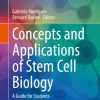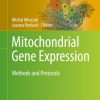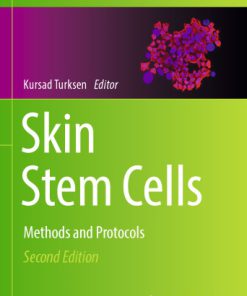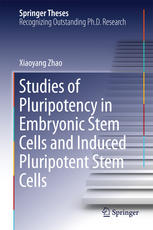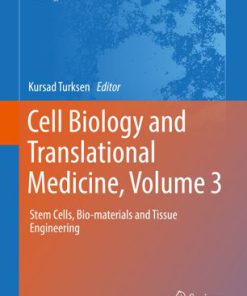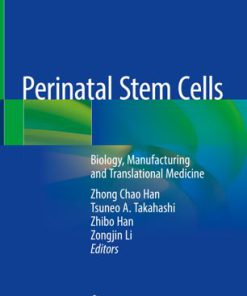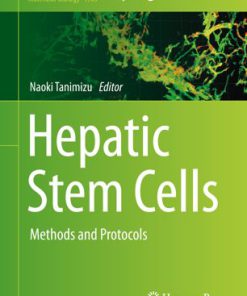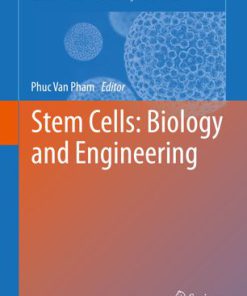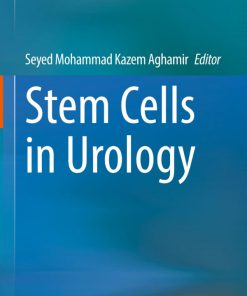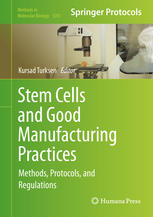Animal and Plant Stem Cells Concepts Propagation and Engineering 1st Edition by Mirjana Pavlovic, Ksenija Radotic ISBN 3319477633 978331947763
$50.00 Original price was: $50.00.$25.00Current price is: $25.00.
Animal and Plant Stem Cells Concepts Propagation and Engineering 1st Edition by Mirjana Pavlović, Ksenija Radotić – Ebook PDF Instant Download/Delivery: 3319477633, 978-3319477633
Full dowload Animal and Plant Stem Cells Concepts Propagation and Engineering 1st Edition after payment
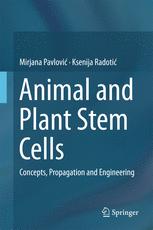
Product details:
ISBN 10: 3319477633
ISBN 13: 978-3319477633
Author: Mirjana Pavlović,, Ksenija Radotić
Written by experts in the field, the book focuses on aspects of stem cells ranging from expansion-propagation to metabolic reprogramming. It introduces the emergence of cancer stem cells and different modalities in targeted cancer stem cell therapies. It is a valuable source of fresh information for academics and researchers, examining molecular mechanisms of animal and plant stem cell regulation and their usage for therapeutic applications.
Students at all levels of medical or engineering backgrounds will enjoy the case studies that illustrate and explain mechanisms, interactions, targeted effects, and multimodal therapeutic approaches. Academics, researchers, and professionals who want to expand their knowledge in this field will find this book an exceptional resource.
Animal and Plant Stem Cells Concepts Propagation and Engineering 1st Table of contents:
1. Introduction
- Bioengineering and Animal Stem Cells
- References
2. Current Status and Perspectives in Stem Cell Research: The Concept of Normal Stem (NSC) and Cancer
- Abstract
2.1 Introduction
2.2 Stemness, Migration, Circulation, and Seeding
2.3 Mobilization
2.4 Similarities and Differences Between Embryonic and Adult Stem Cells
2.5 Similarities and Differences Between Normal and Cancer Stem Cells
2.6 Resume Based upon Similarities and Differences Between NSCs and CSCs
2.7 What and Which Molecular Markers of CSCs We Know Today?
2.8 Isolation of CSCs Using Magnetic Beads
2.9 Theories of Origin of CSCs
2.10 Current Tests for Determination of the Presence of CSCs
2.11 Sorting and Isolation of CTC Using the Method of Magnetic Levitation
2.12 The Emergence/Origin and Development of CSC: Mechanisms
2.13 Aberrant Methylation
2.14 What Do We Need to Do with the Sum of Information?
2.15 How Was the Concept of CSC Therapy Designed? - References
3. Essential Characteristics of Stem Cells: Self-renewal and Plasticity
- Abstract
3.1 The Nature of Stem Cells
3.2 Self-renewal and Its Significance for Stem Cells
3.3 Plasticity/Pluripotency of Animal Stem Cells and Its Mechanisms
3.4 Other Features of Significance - References
4. Stem Cell Sources and Types of Animal Stem Cells
- Abstract
4.1 Introduction
4.2 Embryonic SCs (ES or ESC)
4.3 Fetal Stem Cells (FSC)
4.4 Bone Marrow and Other Adult Stem Cells Sources - References
5. Stemness and Stem Cell Markers
- Abstract
5.1 Introduction
5.2 Human Embryonic Stem Cell Markers and Pluripotency
5.3 Fetal Stem Cell Markers
5.4 Cord Blood Stem Cell Markers
5.5 Placental Stem Cell Markers
5.6 Adult Stem Cell Markers - References
6. Stem Cell Signaling Molecules and Pathways
- Abstract
6.1 Introduction
6.2 ESC-Wnt Signaling- Significant Discoveries in Wnt
6.3 Notch Signaling
6.4 The Human Hedgehog Signaling
6.5 TGF-Beta Signaling
6.6 Signaling Mechanisms in Adult Human Cells (HSC and MSC)
6.7 Pathways in Adult HSC
6.8 Pathways in Adult Mesenchymal Stem Cells
6.9 Pathways in CSC
6.10 The JAK (Janus Kinase)/STAT3 (Signal Transducer and Activator of Transcription) Signal Mechanism
- Significant Discoveries in Wnt
- References
7. Expansion of Stem Cells: Propagation of Animal Stem Cells Ex Vivo (In Culture)
- Abstract
7.1 What Is Expansion and What Do We Expect from Expansion?
7.2 Basic Concept—Ex Vivo Expansion of Hematopoietic Cells Today- Molecules
- Distinct Stimuli
- Media for Expansion
- Hypoxia
- References
8. Stem Cell Pool: What Are the Best Patterns for Cellular Therapy?
- Abstract
8.1 Introduction
8.2 Organogenesis from Adult Stem Cells and Problems with Different Tissues
8.3 Therapeutic Implications for TCSCs as a New Concept
8.4 The Concept of VSEL
8.5 The Concept of Mesenchymal Stem Cells (MSC) with Dental Pulp Cells (DPSCs) as an Example
8.6 Mobilization as a New Noninvasive Therapeutic Concept
8.7 New Concepts in Adult Stem Cell Research with Development of New Strategies: Personal Experience
8.8 Directions and Relevant Studies: We and Others
8.9 Optimization of Primitive Stem Cell Patterns for Regeneration and Repair - References
9. Induced Pluripotent Stem Cells (iPSCs) and Nuclear Reprogramming
- Abstract
9.1 Breakthrough: Induced Pluripotent Stem Cells (iPSC)- Reprogramming as a Therapeutic Event
9.2 Induced Pluripotent Stem Cells (iPSCs) and Nanotechnology: State of the Art
9.3 Nanoparticles for Genetic Reprogramming of Somatic Cells to iPSCs - Poly(Beta-Amino Ester) Nanoparticle-Based Non-viral Protocol
- Calcium Phosphate Nanoparticle-Based Non-viral Protocol
- Polyketal Nanoparticle-Mediated Non-viral, Non-genetic Approach for Delivery of Mature MicroRNAs
- Non-viral Magnetic Nanoparticle-Based Transfection
9.4 The Impact of iPSC upon the Research and Practical Application
- Reprogramming as a Therapeutic Event
- References
10. Cancer Stem Cell Concept
- Abstract
- References
11. Metabolic Reprogramming in Cancer and Metabolic Theory of CSC
- Abstract
11.1 Metabolism of CSC: New Explanations and the Old Fundament
11.2 Terminology of Energy Metabolism
11.3 Coupling of the Respiration with OXPHOX
11.4 Mechanisms of ATP Synthesis
11.5 Metabolic Abnormalities in Cancer Cells and Mitochondria
11.6 The Hallmarks of Cancer Cell Energy Metabolism: The Warburg Effect and the Crabtree Effect
11.7 Resume: Energy Metabolism in Cancer Cell Compromised?
11.8 The Overview on CSC Metabolic Activity
11.9 New Cancer Therapy Concept - References
12. Concept of Targeted Cancer Stem Cell Therapy and New Versions
- Abstract
12.1 The Idea of Targeted Therapy: Before, Now, and in the Future
12.2 Can We Use NSCs in the Therapy of Cancer?
12.3 Mitochondria as the Target
12.4 Other Targeting Possibilities
12.5 New Modalities of Targeted Therapy and Idea of Remote Control
12.6 Principles of Targeted Therapy Based on Nanoparticles
12.7 What is the Best Way to Kill CSC: New Methods?
12.8 Different Combinations of Targeted Therapy
12.9 The Use of Electromagnetic Fields for Growth Inhibition of CSC
12.10 Cancer and Electromagnetism
12.11 Different Principles: Drug Delivery Based upon Nanoparticles of Ferrous Oxide
12.12 3D–Printed Tumor Model
12.13 Computerized 3D Model for Analysis of Aggregation of Tumorigenic Cells Is Revealing Specialized Mechanisms
12.14 Possible Mechanisms of Tumor Cellular Heterogeneity: Mediated Coalescence?
12.15 Summary
12.16 Conclusions
12.17 A Look Ahead; What Does the Future Say? - References
13. HLA Typization Choice of Donors: Match or Match Me Not
- Abstract
13.1 Distinction Between HLA and MSH Genes Molecules and Functions- HLA (Histocompatibility Locus Antigen)
- MHC (Major Histocompatibility Complex)
13.1.6 The Mechanism of Gene Rearrangement Is Contributing to and Allowing for Antigen Diversity
13.1.7 Transplantation Needs Matching to Support Engraftment
- References
14. Engraftment: Homing and Use of Genetic Markers
- Abstract
14.1 What is Engraftment/Homing?
14.2 Genetic Markers - References
15. Nanotechnology in Stem Cell Research
- Abstract
15.1 Nanotechnology/Nanoparticles - References
16. Stem Cell Therapy: Optimization, Regeneration, Reprogramming, Expansion, Tissue Engineering
- Abstract
16.1 Optimization of the Pattern for Stem Cell Treatment
16.2 Regeneration in Animals and Humans
16.3 Nuclear Reprogramming as One of the Methodological Modalities to Get iPSC
16.4 Significance of Expansion
16.5 Stem Cell as a Part of TE Triangle - References
17. What Are Positive Results of Stem Cell Therapies?
- Abstract
17.1 An Overview of Some Disease States in Which Stem Cells Could Help- Heart Attack
- Physically Induced Injury of Neural Tissues
People also search for Animal and Plant Stem Cells Concepts Propagation and Engineering 1st:
difference between animal and plant stem cells
how are animal and plant stem cells different
plant and animal stem cells similar yet different
similarities between plant and animal stem cells
which statement accurately compares plant and animal stem cells
Tags:
Mirjana Pavlovic,Ksenija Radotic,Animal,Plant,Stem Cells,Concepts,Propagation,Engineering 1st
You may also like…
Biology and other natural sciences
Science (General)
Science (General)
Science (General)
Perinatal Stem Cells Biology Manufacturing and Translational Medicine Zhong Chao Han
Biology and other natural sciences
Science (General)
Computers - Hardware
Science (General)
Biology and other natural sciences Biology and other natural sciences - Molecular


